Complexions Contemporary Ballet performs at the Joyce Theater, January 24 through February 5
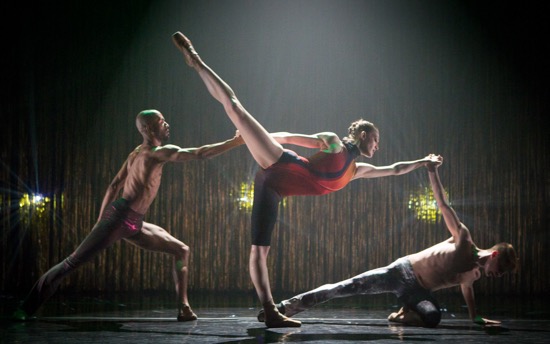
Dwight Rhoden’s Star Dust. (L to R): Anthony Javier Savoy, Jillian Davis,and Doug Baum. Photo: Yi-Chun Wu
Some dances aim to hit you over the head—not too hard, just enough to get your adrenaline rushing. Look at the dancers: strong, confident, beautiful, they can do anything. When they swing their legs into the air, a tree could fall. Their idea of a rest is shooting off a few very slightly less explosive moves.
We can all probably think of choreographers and companies that fit the above description, but in this case, I’m talking about Dwight Rhoden’s works for Complexions Contemporary Ballet, currently entering its second week of performances at the Joyce Theater. Rhoden and Desmond Richardson (both onetime members of Alvin Ailey American Dance Theater) founded the company in 1994. Carmen de Lavallade and Sarita Allen, listed as artistic advisors, also have histories with AAADT. But Rhoden and Richardson have since done extensive work elsewhere. Reading Rhoden’s bio, you wonder how he manages it all—choreographing for Complexions and other companies, teaching, touring, and, according to his bio, “directing and choreographing for TV, theater, film, and live performances.”
It’s not surprising that Rhoden is a dynamo in terms of eclecticism, but it is surprising that he has built it into a style. You come to expect moves like one in which the dancer swings one straight leg high and around to instigate a turn, tilting slightly forward as she/he does so. You expect a kind of ornamentation, in which a step hits its peak, mildly retracts or is interrupted, and presses on again—all at warp speed. What might be termed “extreme ballet” snuggles up to rolling on the floor, runway struts, and jagged frenzies of slashing, stabbing limbs. What might loosely be described as an arabesque supported by a partner looks like a dive because of the way the performer attacks it. (The dancer sitting beside me at the Joyce agreed that after watching Rhoden’s Gutter Glitter, a world premiere, our hip joints hurt in kinesthetic sympathy). Seven of the fifteen dancers listed in the program joined the company in 2014; you can wonder whether those they replaced headed for the operating room or just to slightly more temperate choreography.
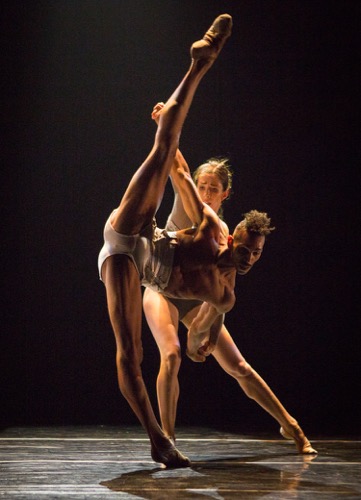
Clifford Williams and Natiya Kezevadze in Dwight Rhoden’s So Not A. . .(An Epilogue to Gutter Glitter). Photo: Yi-Chun Wu
I could wish for more textural variety and more nuanced dynamics, but the audience at the Joyce is thrilled with Gutter Glitter, the first installment of what’s to be called “The Collage Series.” The music credit simply reads “various.” What sounds like doctored Bach plays ball with stormy up-to-date stuff such as, maybe, “Until the Very Last Breath.” The program note begins like this: “ITSAMATTEROFINBOXZEROBAMADRAMAENDGOALTHERIGHTAMOUNTOFWRONG. . . .”
Collage, montage, whatever, Gutter Glitter is very, very long. Rhoden seems addicted to excess. And while he is adept at manipulating elements of structure (themes, movements, and images that eventually repeat), and he can delight the eye, he obviously equates slowing down or pruning with death. Several times, Gutter Glitter offers a climactic moment that feels like an ending, and the audience starts to clap. But, no, there’s more. And more. Even heroic beauty and phenomenal athleticism can begin to weigh on you.
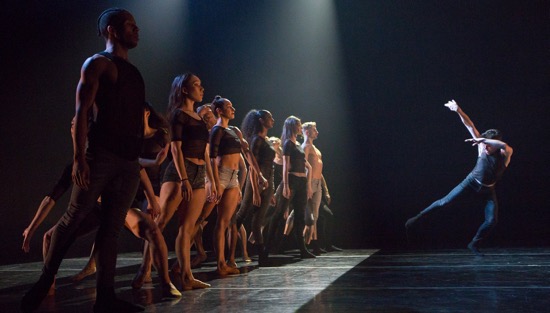
Dwight Rhoden’s Gutter Glitter. (L to R): Complexion dancers Greg Blackmon, Laura Lopez, Larissa Gerszke, Maria Gerasimou, Natiya Kezevadze, Andrew Brader. Far right: Timothy Stickney. Photo: Yi-Chun Wu
The beginning of the work shows Rhoden at his best. Twelve dancers stand stage right in a line that extends from the front of the stage to the rear; another man walks alone, and still another twists on the floor. Rhoden then sets those in the line leaving it to create a tempest of motion, and re-forming it with dazzling speed. They rush into a cluster, lift someone, return to home base again. Odd images freighted with drama occur (a man muzzling a woman with his hand) and disappear; organized tumult seethes up. Five people dance in place. Three-part counterpoint develops. It’s exciting.
However, in the dance as a whole, Rhoden creates a pattern of interruption and replacement that eventually begins to pall. People finish what they’re doing and rush away, as if they’d heard a bugle summoning them to reveille. Maybe some remain while others race onto the stage and are absorbed into the new big gusts of dancing. After a while, you start to wonder where they’re running or why. Is this a big party with many rooms, and they’re somewhere else taking the deep breaths that I wish Rhoden would allow us to have? What eventually wearies me, I think, is that there are so few changes in timing or dynamics or ideas. The choreography just hammers away at us in an ambiance that the masterly lighting designer Michael Korsch keeps shifting—laying patterns on the floor, creating a pool of red light, and more.
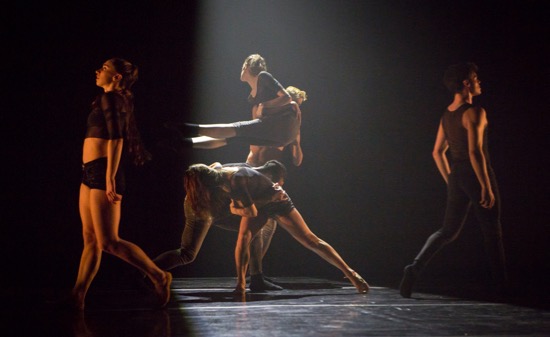
Complexions dancers in Gutter Glitter. Shanna Irwin (L) and Timothy Stickney (R). Front couple: YoungSil Kim and Greg Blackmon. Rear couple: Jillian Davis and Andrew Brader. Photo: Yi-Chun Wu
Rhoden has written that, although he has created an “abstract landscape,” it’s made of “contrasting ideas, juxtaposing stories, characters, and environments that are diverse in origin.” A difficult challenge. The stories seem no more than a passing hint, unless you count men partnering women. Maybe dancers suddenly shaking their fingers or holding a hand over one eye allude to a drama. Once, two dancers stand down right, watching the action ebb from the stage, and for a second or two, I think of Adam and Eve ready to leave paradise. However, we see and admire various individual performers far more for their prowess than as characters. Tall, supple Terk Lewis Waters is definitely a leader of some sort. Standing on one leg and stretching the other one high, he all but spans the stage. Near the beginning, he performs a compelling solo that he later repeats; among other things, it involves him standing centerstage and making brisk, sharply defined designs with his arms, as if laying down the law. We notice and admire tall, lanky Jillian Davis, small Doug Baum, who dances big, and others. But Waters is almost the only one we get to know in this dance (or think we know). Also artists in residence Clifford Williams and Natiya Kezevadze (born and trained in Russia) who perform together—powerfully—in the brief ensuing So not a. . .(An Epilogue to Gutter Glitter), set to music by Handel.
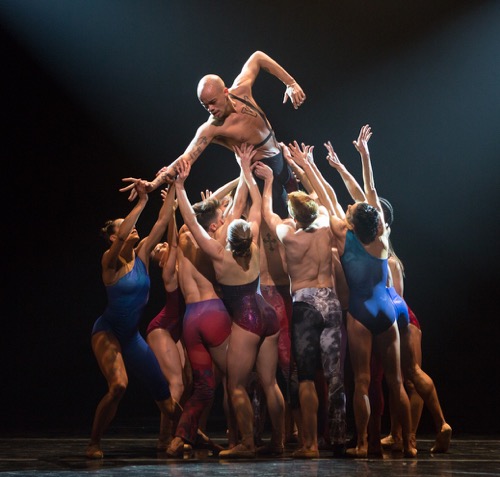
The cast of Dwight Rhoden’s Star Dust lifts Terk Lewis Waters. Photo: Yi-Chun Wu
Star Dust (a New York premiere) is shorter, and the nine variegated recorded songs that accompany are all by David Bowie (the piece is a tribute to him). In several of the numbers, selected company dancers lip-synch the singer expertly, parading around as they do so. You may cringe, trying to imagine this, but they do it so expertly and with such pleasure—strutting, flirting aggressively with us, really getting into the persona—that they hold the dancing together.
Korsch’s lighting amps up the atmosphere. Rays of light rotate or, once, fan out from single sources that beam them over us. A couple of times, a curtain of silver streamers slides across the back of the stage, then retreats. Christine Darch’s costumes are streamlined and neon bold. The dancers’ faces bear painted designs and, for instance, blue-green lips and eyelids. One of the first things the performers do is run on, pair up, and slump against each other. Otherwise they’re parading around—the women slinky, hippy, and on pointe for some reason—and executing big, flashy moves. Often, they strike a pose and hold it for a while. A couple of times, the terrific YoungSil Kim and Kelly Marsh IV stand out vividly in short, emotional duets, but the choreography doesn’t get under the skin of each song, focusing more on the performance inspired by it.
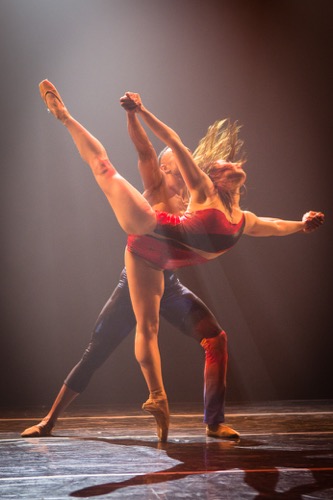
YoungSil Kim partnered by Kelly Marsh IV in Star Dust. Photo: Yi-Chun Wu
Bowie’s songs—fantastic, boyish— and his androgynous presence still resonate with us. The “singers” are the ones we watch most: the magnificent Waters; Andrew Brader; Greg Blackmon flinging his shock of purple-tinted hair around; Sergio Arranz on pointe, whipping off a string of turns; Davis, briefly; and, finally, Baum in passionate, gut-wrenching spasms to Rock and Roll Suicide. One of the strongest ensemble moments is one in which five men partner Arranz into outer space.
Other dancers featured are Timothy Stickney and Anthony Javier Savoy. When the final curtain slowly descends, everyone in the cast is dancing with all the spirit he or she can muster. Which is, believe me, a great deal.

And now I know what a Complexions performance is like, since I’ve never seen the company. Thanks Deborah.
You deserve a medal.